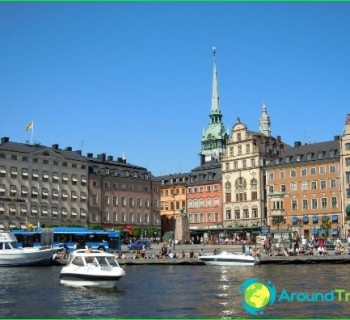Sweden flag

The flag of Sweden has existed since about the 12th century, so the history of its origin is little known. Various legends tell about the origin of the blue flag, on which there is a bright yellow Scandinavian cross. According to Swedish law, the dimensions of a rectangular panel correspond to a ratio of width to length of 10 to 16.
Legend has it that during a prayer to King Eric IX, before a battle with a tribe of Finnish paganism, a golden cross appeared in the rays of the sun, depicted in a blue sky. King Eric and his warriors won the battle, and then the main color symbols of the Swedish kingdom became yellow (gold) and blue (light blue).
The existence of the flag of Sweden is mentioned in historical documents of the 15th century. There is an assumption that the early proportions of 5 to 8 were copied from the Danish cloth, and the colors were taken from the military coats of arms of the Swedish army. The battle shields, divided into four parts, were decorated with the three crowns of Sweden and the lion of the Folkung dynasty. Charles VIII introduced this symbolism for his soldiers in the middle of the 15th century. From such historical events came the symbolic decoration of the coat of arms and flag of Sweden. A royal decree was introduced stating that the yellow cross must be present on Swedish personal and military banners.
There is a slightly different version of the appearance of the Swedish flag: the color scheme could be borrowed in the 13th century from the royal coat of arms of King Magnus I Ladulosom, or in the 14th century - from the coat of arms of King Albrecht of Mecklenburg. Some sources say that the original Swedish cloth was white, not yellow or blue. And already at the beginning of the 15th century, the color of the flag was changed.
Since history claims that the Swedish flag was copied from the Danish flag, it is possible that this design was used as a symbol of opposition to Danish rule. The Scandinavian countries depict a cross on their flags, just like on the Swedish flag, which signifies common unity and history. At the beginning of the 19th century, Norway and Sweden used the same flag.
The Day dedicated to the Swedish Flag has been celebrated on June 6 since the beginning of the 20th century, and this day has been proclaimed as the National Day of Sweden. Why is this number chosen? Because on this day in the 16th century, Gustav Vasa was crowned, who became the king of Sweden, who gave rise to the independence of the state. And already in 1809, on the same day, Sweden established a new constitution, which gave more powers and freedom of action to the citizens of Sweden..


